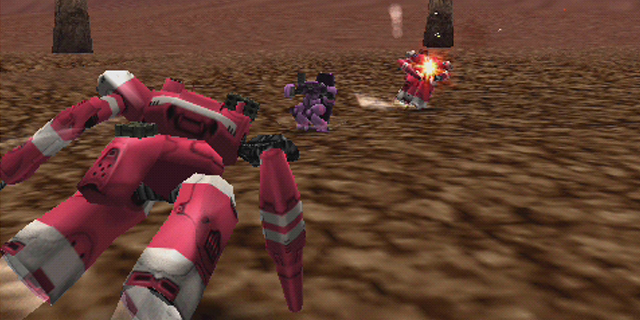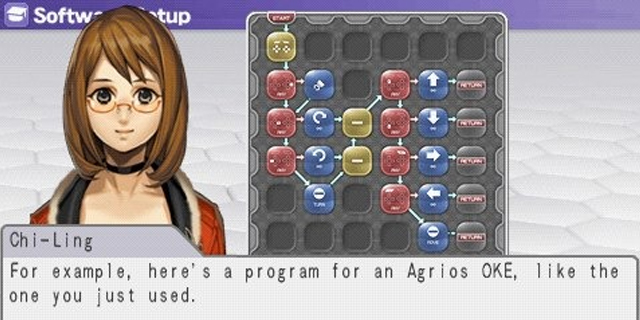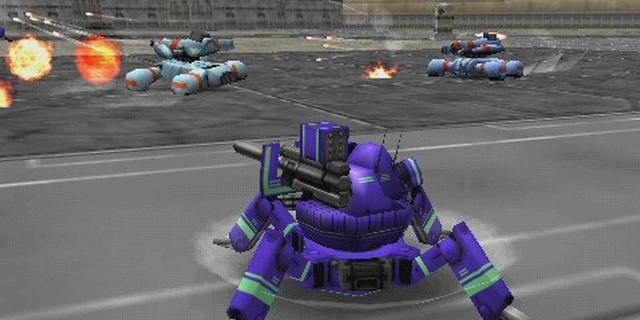
The latest in a long line of games by developer Artdink and only the second to make it to the West, Carnage Heart EXA is not your typical game. It feels more like a programming training tool, with a very specific language and no external applications. That’s not to say it isn’t fun by any means, though. It’s just important to know going in just exactly what you’re getting into.
In the Carnage Heart series, which hasn’t seen American release since the first game on the original PlayStation in 1997, you program and (sometimes) operate Overkill Engines, or OKEs. These are robots, so you can probably just call them robots, but, you know, it’s up to you. You program them by putting chips onto grids and pointing different paths based on outcomes. These generally come in two forms: ones you control directly, and automated programs that work on their own. The two types use the same interface, but understandably, coding them is very different. For one, you have to check whether buttons are pressed and take actions based on those checks. For the other, you’re putting in commands like “shoot at the nearest enemy, then move toward them, then, when you’re close enough, use a melee attack.”

Putting these together is incredibly complicated at first, and the game knows it. That’s why a significant number of hours at the beginning of the game’s story mode are devoted to dozens of mandatory tutorials. If you’re familiar with programming logic, this can be a bit frustrating. If you’re not, it’s the only way you’re going to know what you’re doing. You can always go into the game’s battle mode instead, but even seasoned coders will want a bit of explanation here and there regarding the menu and various functions. Generally, if you want something you can pick up and play, Carnage Heart isn’t it. It’s not a diversion in your game library; it’s a hobby all to itself.
If you have the time and dedication needed to stick with it for a while (and the story, while fine, is always just a bit too on-the-nose to keep you hooked), there are really some cool parts to Carnage Heart EXA that you’re not getting with any other game. If you really like developing and customizing teams in RPGs, you may find yourself fascinated by building OKEs with very specific parts and programming logic to your exact wishes, then sitting back and hoping it holds its own against the competition. You’re always treading the line and hoping you don’t go too far; while you definitely get larger and more complex components as the game goes on, there’s a “the bigger they are, the harder they fall” mentality to the game’s balance. You have a larger CPU to program more moves into? You’ll either have to deal with a slower processing speed, or you’ll be super-susceptible to overheating and shutdown, leaving you vulnerable at the worst moments.

Even still, a crafty piece of software can give you an edge. Sure, there are limited types of melee attacks, but you can cobble together new ones by interrupting motions as they’re in progress. (To the game’s credit, this is one of the first things it shows you to do, letting your mind start to think of the possibilities in future contexts.)
There are definitely some rough parts to programming your own experience, though, namely that, even with a lot of practice, most aren’t as good as professional combat designers. You’ll find your setup functional, but likely come away from EXA appreciating the smooth movements and logical schemes of other games you play. This is less of an issue with automated OKEs, and the “see what happens” nature of these fights is what Carnage Heart does best.
As a 2013 North American PSP release, EXA will likely see much of its play on the Vita, and it transfers here just fine. It wasn’t a visual showpiece even on its original system, so that part’s no big deal, and you can use the second analog stick to at least some effect if you wish, as you’re programming your own controls anyway. (Of course, you don’t actually get two analog sticks, but it can mimic the D-pad and get fairly close. If you code it right.)
More than a game, Carnage Heart EXA feels like a virtual kit for making and competing with your own custom BattleBot. It takes about as much dedication, too. But much like programming itself, what you get out of it is very much based on what you put in.
Pros: Interesting possibilities for coding, lots of customization and possibility
Cons: Multi-hour mandatory tutorial may be too much for most, story is lackluster



















